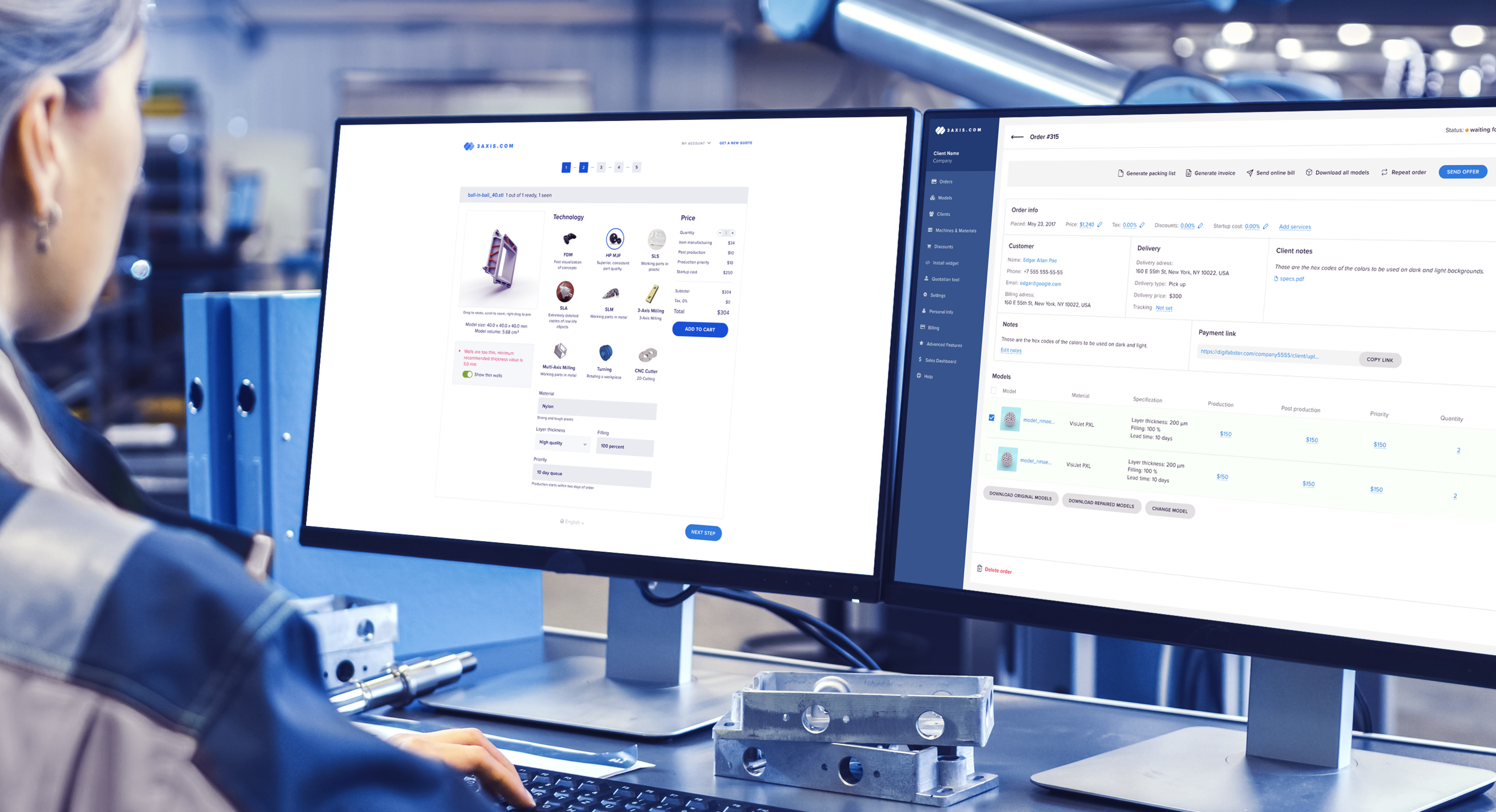This is a guest post from DigiFabster, a US-based manufacturing software firm specializing in instant quotation and lead conversion tools tailored for digital manufacturing.
As individual shops and the 3D/AM industry overall move from one-off prototyping towards mass production of end-use parts, they need the right software to support their scaling efforts.
Scaling your sales
When moving from one copy per model to 10 copies or 1,000, manual quoting becomes trickier and more time consuming. To ease this common pain point in their growth, AM shops are increasingly turning to automated quoting solutions that calculate this economy of scale and display it for the customer, so they can see the benefit of ordering bigger batches.
In traditional industries such as CNC milling and turning, prices are closely linked to the number of identical parts ordered for a simple reason: The cost of preparation for one part is the same as 1,000 parts, so that cost can be divided between the number of identical parts ordered.
This one-off cost is relatively high in CNC: The price when ordering one part is roughly 9:10 one-off costs, 1:10 material and machining costs. Explaining that one-off cost to the customer is different from injection molding. For example, where you can point to a mold and say, “That piece of hardware costs $10,000.”
In CNC, the one-off cost is made up of many small immaterial parts like programming, preparing jigs, and so on, but trying to explain this to the customer is difficult. Therefore, there is one price for one identical part, another for 10, and another for 100, presented in a clear table format, from which the customer can pick and choose their quantity and price.
This has the added benefit of stopping most customers from asking for discounts because the “discounts” are already laid out in front of them. They just have to make a choice between more parts in stock with lower prices or less parts in stock with higher prices.
Going for $11.12 instead of $189.00 above and reporting a 1700% discount is an opportunity few supply chain managers are able to resist.

Quoting software handles the added complexity for large AM orders
It makes sense for AM shops to present their quotes the same way; it cuts down on time spent communicating with the customer and stimulates bigger orders.
The math behind a table like the one above is fairly simple, as long as there are two distinct data points: one-off costs per part, and material and production costs (time) per part. Automated quoting tools for the AM industry now offer such a split between one-off and per parts costs, which allows tables like these to be generated quickly and accurately at the point of sale.
However, there is an added layer of complexity for AM, which involves deciding which model parameters better correlate to one-off costs, and which correlate better to per-part cost. In powder-bed machines, for instance, the height of the model would be a good parameter for one-off, since the parts are sharing the swipe time, whereas the material consumption would be a great candidate for the per-part cost.
Different shops and technologies demand different approaches to this decision, but there’s no technical difficulty for the quoting software to offer all model parameters for both one-off and per-part costs.
The last step is figuring out the fixed overhead cost per sale, which is inherently low if you’re using an automated quoting/ordering system, but it still needs to be factored in. Those figures would be input as a fixed sum to the one-off costs.

Streamline large quantity orders with a simple interface
When moving away from the prototyping space and into the mass-manufacturing space, AM shops need to take a number of other factors into account: Buyers will come from different backgrounds, so your quoting and selling interface should be flexible. For example, it can allow purchase orders to be uploaded, and let buyers choose the standards by which they want their parts to be produced. In general, it should look professional and respond quickly with minimal wait time or glitches.
All of the above are features of online quoting software for AM technologies. There are digital platforms that build on the quoting principles of mass CNC production and provide white-label instant quoting and e-commerce solutions for a flat subscription fee. These solutions are generally easy to implement and offer your business a fast track not only to producing mass quantities, but also cutting down on the time and labor you’d otherwise spend quoting, all while providing your customers a seamless ordering solution.
Readers can find out more about DigiFabster’s tools to optimize production planning for their 3D printing operations here.
Subscribe to the 3D Printing Industry newsletter for the latest news in additive manufacturing. You can also stay connected by following us on Twitter and liking us on Facebook.
Looking for a career in additive manufacturing? Visit 3D Printing Jobs for a selection of roles in the industry.
Subscribe to our YouTube channel for the latest 3D printing video shorts, reviews and webinar replays.
Featured image shows DigiFabster’s quoting tool in action. Photo via Digifabster.



